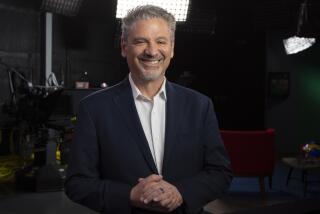C’mon, Howard, We All Want Better News
- Share via
There can be reasons to criticize the ways that local news uses live shots. But Howard Rosenberg’s criticism of News Director Larry Perret’s memo about the ways that Channel 2 should use live shots was just plain wrong.
“A frightening memo,” Rosenberg blasts Perret’s advice to his news team (“Bringing Closure to Anchors’ Glibness,” Calendar, Sept. 23).
What is this awful thing that Perret decrees? He says, “The anchors must provide a sense of closure to these (live) stories.” That this frightens Howard Rosenberg frightens me.
I have done probably hundreds of live TV reports. For seven years I worked as a reporter in local TV newsrooms managed by Larry Perret. His priorities have never been, as Rosenberg writes, “scripted performances,” “theatrics” or to “prop up news anchors.”
What Perret wants is what viewers want--news delivered in an accurate, timely, clear and compelling way, with a beginning, a middle and an end.
I’m now on the other side of the tube, happy to be a stay-at-home mom. I watch live reports from the viewer’s point of view now. And I’m often frustrated by the lack of clarity and context. Just because a report is live is no excuse for stinting on good storytelling. Since live reports start off and end up at the anchor desk, logically anchors should have a part in crafting good stories.
Rosenberg’s own high and mighty medium accomplishes this with many other elements besides reporters’ words. Articles start off with headlines. In TV news, the anchor introduction is the headline. Would Rosenberg do away with headlines? He scoffs at anchors providing closure--would he kill their openings too? “Anchorless” newscasts don’t work. It’s been tried. And it’s too confusing.
But a major concern is how, in Perret’s words, to keep anchors from “simply playing the role of traffic cop.” That was his reason for the memo and it is an important problem because it does significantly impact viewers.
You may not realize why you don’t like a badly produced newscast but, trust me, you won’t like it if anchors bounce from live report to live report, without pause for context or the simple human need to take a moment to absorb what you’ve just seen and heard.
*
Newspapers do this too. Important stories run with sidebars, which might contain additional information, add context, give perspective or insight, or historical perspective.
That is exactly what Perret asked of his anchors.
Quoting his memo: “The anchors should provide additional information, add context, give perspective or insight, or historical perspective. Any of the above will help give a sense of closure to a live report.”
When newspaper editors write memos about this, it’s touted as comprehensive coverage. Yet when a smart news director wants to do the same thing, it’s criticized as slick packaging. Come on.
One further point that Rosenberg should have learned long ago: The logistics involved in getting a lot of live shots into a daily newscast are daunting. Good reporters and anchors try to brief each other before they go on-air but there’s usually not enough time.
Anchors have many stories to prepare for. Reporters have only one. So it’s rightly up to the reporter to communicate information to a writer or producer, who is responsible for getting all the elements of a report ready for air. Writers and producers arrange graphics, identify interviewees and locations, and help check facts, among many other crucial tasks.
At Channel 2 now (as he did at Channel 9 and Channel 11), Perret also wants writers and producers to provide additional information that anchors can use to draw a live report to a conclusion.
I’ve been doing this successfully for years. I prefer to talk directly to anchors about my reports. I may tell them where to advise viewers to go for more information, or I may engage anchors in a discussion about a controversy brewing over the story I just did.
I try, but in the real world of breaking news and relentless deadlines, there’s rarely time to talk directly. So I call a writer or producer. They are the link between the field and the studio. They are valued professionals--not unheralded, underpaid puppeteers pulling the strings of anchors’ lips, as Rosenberg would wrongly have you believe.
More to Read
The complete guide to home viewing
Get Screen Gab for everything about the TV shows and streaming movies everyone’s talking about.
You may occasionally receive promotional content from the Los Angeles Times.






